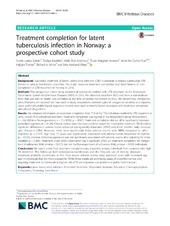| dc.contributor.author | Schein, Yvette Louise | en_US |
| dc.contributor.author | Madebo, Tesfaye | en_US |
| dc.contributor.author | Andersen, Hilde Elise | en_US |
| dc.contributor.author | Arnesen, Trude Margrete | en_US |
| dc.contributor.author | Dyrhol-Riise, Anne Ma | en_US |
| dc.contributor.author | Tveiten, Hallgeir | en_US |
| dc.contributor.author | White, Richard Aubrey | en_US |
| dc.contributor.author | Winje, Brita Askeland | en_US |
| dc.date.accessioned | 2019-04-16T08:48:21Z | |
| dc.date.available | 2019-04-16T08:48:21Z | |
| dc.date.issued | 2018-11-19 | |
| dc.Published | Schein YL, Madebo T, Andersen HE, Arnesen T, Dyrhol-Riise AM, Tveiten, White R, Winje BA. Treatment completion for latent tuberculosis infection in Norway: a prospective cohort study. BMC Infectious Diseases. 2018;18:587 | eng |
| dc.identifier.issn | 1471-2334 | |
| dc.identifier.uri | https://hdl.handle.net/1956/19347 | |
| dc.description.abstract | Background: Successful treatment of latent tuberculosis infection (LTBI) is essential to reduce tuberculosis (TB) incidence rates in low-burden countries. This study measures treatment completion and determinants of non-completion of LTBI treatment in Norway in 2016. Methods: This prospective cohort study included all individuals notified with LTBI treatment to the Norwegian Surveillance System for Infectious Diseases (MSIS) in 2016. We obtained data from MSIS and from a standardized form that was sent to health care providers at the time of patient notification to MSIS. We determined completion rates. Pearson’s chi squared test was used to study associations between pairs of categorical variables and separate crude and multivariable logistic regression models were used to identify factors associated with treatment completion and adverse drug effects. Results: We obtained information on treatment completion from 719 of the 726 individuals notified for LTBI treatment in 2016. Overall, 91% completed treatment. Treatment completion was highest in the foreign-born group [foreign-born, n = 562 (92%) vs Norwegian-born, n = 115 (85%), p = 0.007]. Treatment completion did not differ significantly between prescribed regimens (p = 0.124). Adverse events were the most common reason for incomplete treatment. We found no significant differences in adverse events when comparing weekly rifapentine (3RPH) with three months daily isoniazid and rifampicin (3RH). However, there were significantly fewer adverse events with 3RPH compared to other regimens (p = 0.037). Age over 35 years was significantly associated with adverse events irrespective of regimen (p = 0.024), whereas immunosuppression was not significantly associated with adverse events after adjusting for other variables (p = 0.306). Treatment under direct observation had a significant effect on treatment completion for foreign-born (multivariate Wald p-value = 0.017), but not for Norwegian-born (multivariate Wald p-value = 0.408) individuals. Conclusions: We report a very high treatment completion rate, especially among individuals from countries with high TB incidence. The follow-up from tuberculosis-coordinators and the frequent use of directly observed treatment probably contributes to this. Few severe adverse events were reported, even with increased age and in individuals that are more susceptible. While these results are promising, issues of cost-effectiveness and targeting treatment to individuals at highest risk of TB are important components of public health impact. | en_US |
| dc.language.iso | eng | eng |
| dc.publisher | BioMed Central | eng |
| dc.relation.uri | https://www.ncbi.nlm.nih.gov/pmc/articles/PMC6245849/pdf/12879_2018_Article_3468.pdf | |
| dc.rights | Attribution CC BY | eng |
| dc.rights.uri | http://creativecommons.org/licenses/by/4.0 | eng |
| dc.subject | Latent tuberculosis infection | eng |
| dc.subject | Preventive treatment | eng |
| dc.subject | Rifapentine | eng |
| dc.subject | Isoniazid | eng |
| dc.subject | Rifampicin | eng |
| dc.subject | Chemoprophylaxis | eng |
| dc.subject | Compliance | eng |
| dc.subject | Screening | eng |
| dc.subject | Surveillance | eng |
| dc.title | Treatment completion for latent tuberculosis infection in Norway: a prospective cohort study | en_US |
| dc.type | Peer reviewed | |
| dc.type | Journal article | |
| dc.date.updated | 2018-12-11T12:59:29Z | |
| dc.description.version | publishedVersion | en_US |
| dc.rights.holder | Copyright 2018 The Authors | |
| dc.identifier.doi | https://doi.org/10.1186/s12879-018-3468-z | |
| dc.identifier.cristin | 1641710 | |
| dc.source.journal | BMC Infectious Diseases | |

